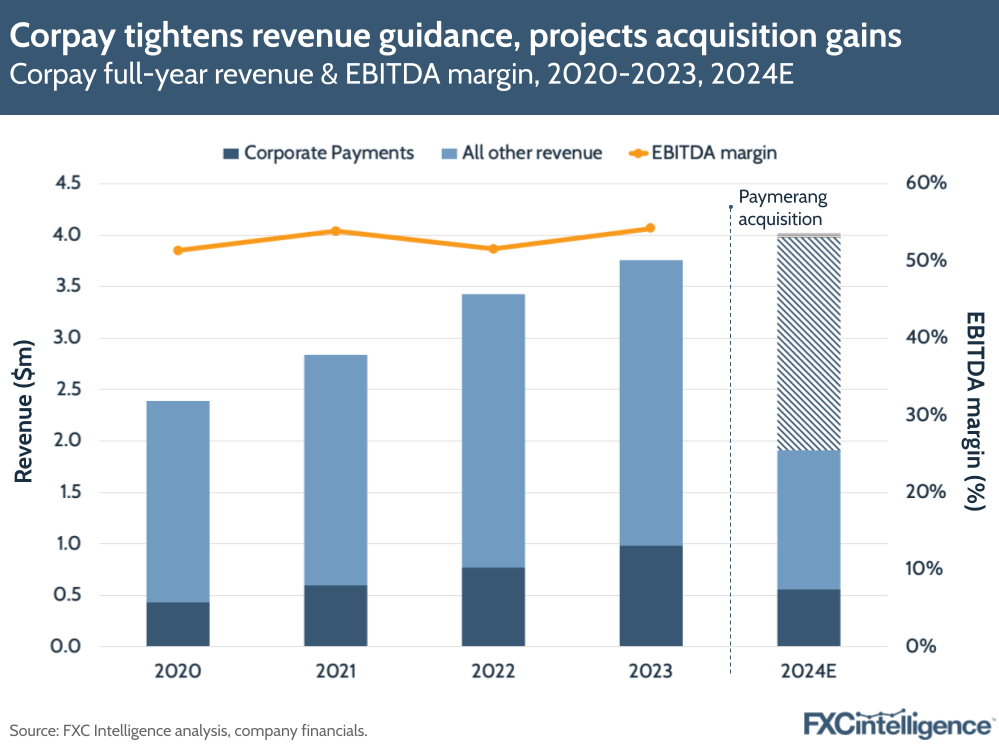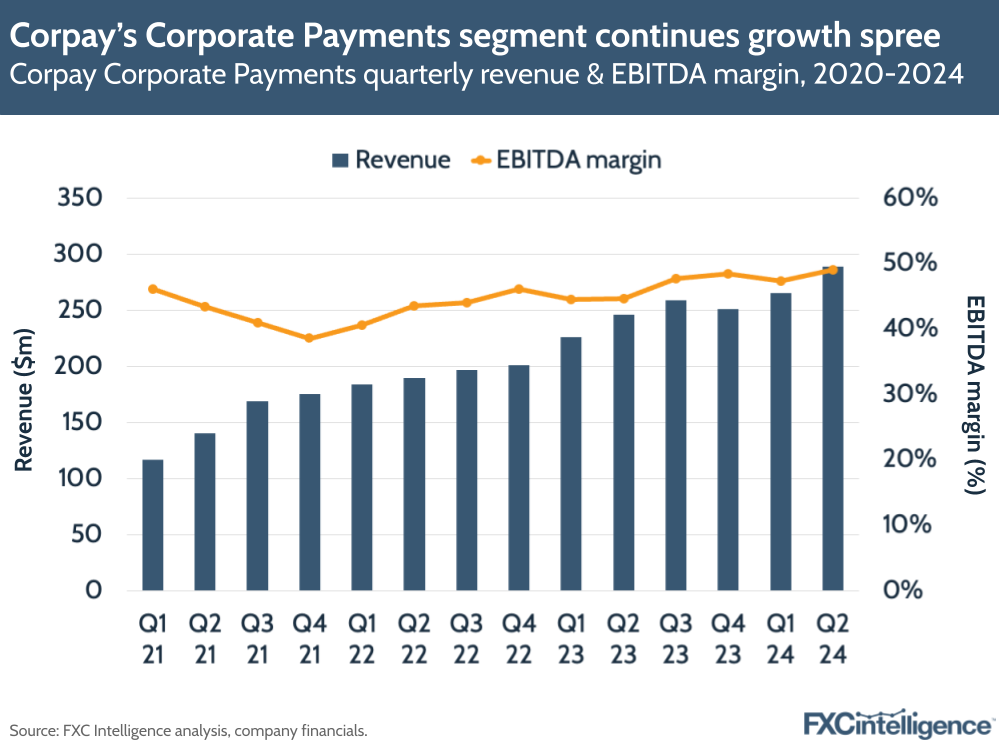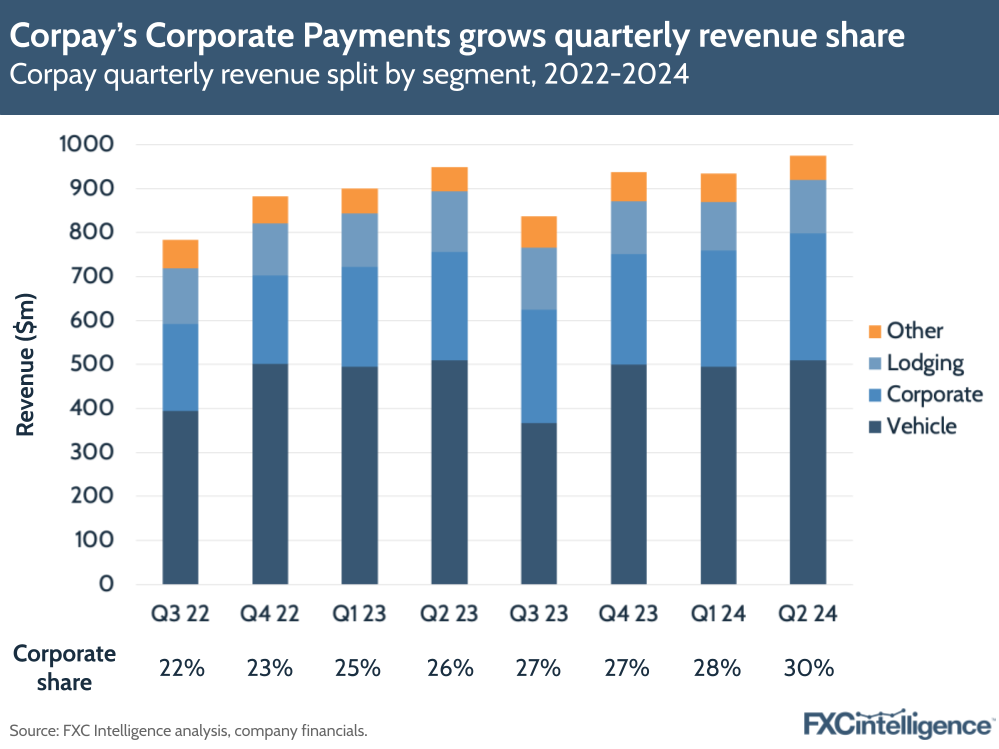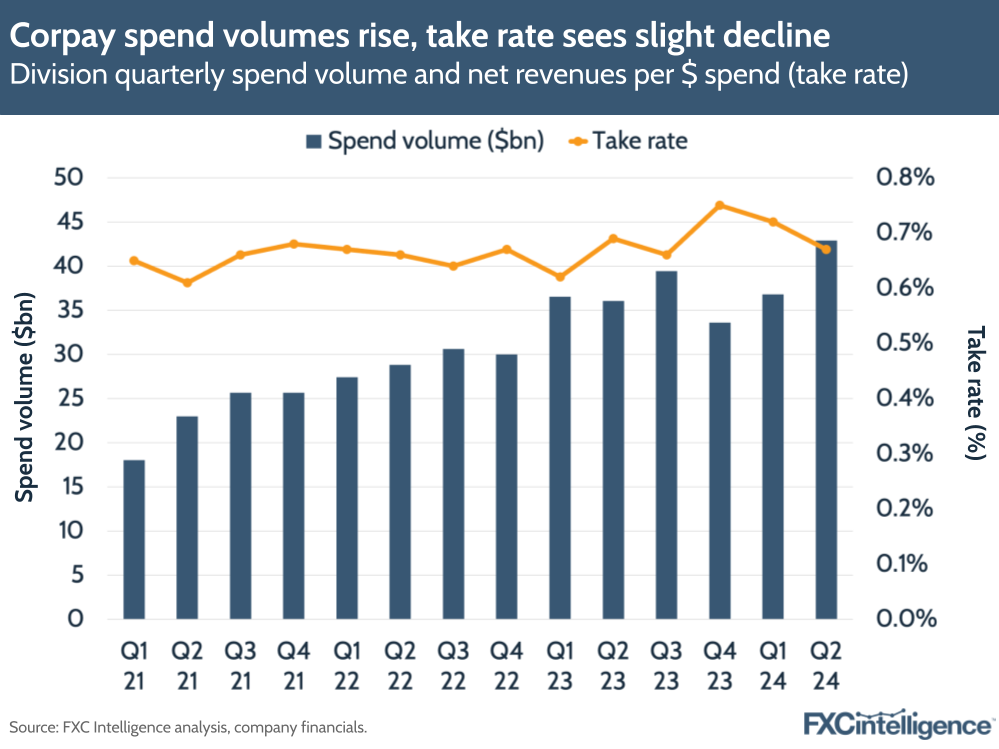Corpay continued to see Corporate Payments lead growth in Q2 2024 as it integrates recent acquisitions and moves towards becoming an “international bank of choice” for corporate payments. We found out more about the company’s key revenue drivers and strategy from Corpay Cross-Border Solutions Group President Mark Frey.


Corpay (formerly Fleetcor) once again saw strength from corporate payments driving growth in Q2 2024, with overall revenue rising 3% to $976m, or 7% excluding its Russia business.
Corporate Payments (formerly Corpay) once again outperformed other divisions, with revenue rising by 17% to $289m, a 30% share of Corpay’s total. It also delivered $141m in EBITDA. This contributed to a 4% growth in the company’s overall EBITDA to $518m, giving Corpay an EBITDA margin of 53% – a 60 bps YoY increase. Overall, cross-border revenues increased 19%, while sales grew 25% during the quarter.
Corpay slightly tightened its FY 2024 guidance to $3.98bn-4.03bn (from $3.96bn-4.04bn), adding that an unsettled macro environment had made it more likely that revenue would be towards the lower end of the range. Having said this, the company still expects low to mid-teens growth led by Corporate Payments growing more than 20%. It also projected further growth from its acquisition of invoice and payment automation platform Paymerang in July, as well as its upcoming acquisition of B2B payment processor GPS.
I caught up with Mark Frey, Group President of Corpay Cross-Border, to find out what’s driving the company’s payments and risk management divisions, as well as the company’s move towards a multicurrency account-led approach.
Corpay’s Q2 2024 revenue growth drivers
Daniel Webber:
Mark, great to be here with you. You’re growing faster than the market, which is great. What’s driving that?
Mark Frey:
The growth has been very healthy: in and around the high teens to 20% quarter-on-quarter pretty consistently going back a number of years now. It is really driven by two simple things. We retain customers and revenue very well – in the mid to high 90 percentages in terms of our overall existing core revenue, when we factor in our base revenue.
When we look at our customers from 2023 and what they produce in 2024, it’s more than 100%. We sell more than 20% of the base every year and we turn those customers on and begin to generate revenue from them very quickly, with a timely and aggressive implementation schedule for the API integration payment partner customers, and for our hedging customers that are on hedging programs and leveraging our technology, we try to get them ramped up and at scale very quickly.
The business is continuing to focus on those key things, rolling out new products that further differentiate our product offering in the marketplace, making it easier to sell and adding more points of differentiation and value with our clients. It’s all gone pretty well.
It’s challenging as the business continues to scale. In 2025, we’ll be close to a billion-dollar revenue business in just the cross-border enterprise. We operate an EBITDA margin in the mid to high 50% range – so 56%, 57% – and on occasion that approaches 60%.
So, it’s a very profitable, fast-growing business with sustainable growth, and it’s very consistent quarter-on-quarter.
Acquisitions set to drive further growth, corporate payments revenues

Corpay completed its acquisition of invoice and payment automation platform Paymerang on 1 July, and this is expected to contribute approximately $25m-35m to H2 2024 revenues, helping spur 6% revenue growth in Q3 2024. GPS, which the company announced it would be acquiring in June, is expected to add over $125m of revenue in 2025, increasing the company’s scale, particularly in the US.
Corpay expects the acquisitions to together add about 15% to the company’s Corporate Payments revenue next year, driving Corporate Payments to overall represent about 40% of the overall company by the end of that year. In Q2 2024, Corporate Payments accounted for 30% of the total revenue share.
On future M&As and deals, Corpay CEO Ronald F. Clarke said during the earnings call that the company had “a couple of interesting deals in the pipeline” and the company had the liquidity to progress with these if they pass due diligence – but didn’t clarify if these were related to Corpay’s cross-border payments business.
Trends in Corpay’s cross-border payments business
Daniel Webber:
What trends are you seeing for your cross-border payments business?
Mark Frey:
The payment side is really driven by a few key factors. In-country capability and low-value delivery capability are key differentiators for us.
The ability to deliver in-country, low-value ACH-equivalent payments in more than 60 markets around the world – that’s a super important part of what we do. Then there is the ability to reach the frontier and emerging markets in Central America, South America, Africa and Asia; to deliver payments at scale for cash at TOM [tomorrow] and spot value; and to deliver reliably both for larger wholesale transactions and or smaller consumer payments.
Whether we’re delivering international payroll or whatever the case might be, being able to deliver on-time, full value transfers in distributed markets around the world is a key differentiator. We do that not only for our corporate customers; we built that capability originally to resell to other major financial institutions (FIs). So the world’s largest FX banks are coming to us looking for liquidity in South America, Africa and increasingly in Asia.
Then we take that same capability and we offer it to our corporate customers. That’s a huge differentiator for us, so that network of payout capability is super important.
Then it really comes down to the front-end technology. A key question is: how can you integrate with your customers? Whether it’s via an API to their own front end; an enterprise resource planning (ERP) integration; connecting via Microsoft, NetLead or Xero, or something else where we’ve got a direct integration to the core processing engine of the corporate customer; or whether it’s a core banking ERP. A big part of what we have done is focused our FI business on connecting to the core platforms that service the banking sector, so it’s easier for us to switch on those FI customers really with a flick of the switch.
If you are a bank that is powered by Jack Henry, ultimately you can gain access to our cross-border capability in a very light-touch fashion with no integration work from your IT team. A big part of our success and payments growth has been focusing not just on growing that corporate segment, but from FIs and non-bank FIs, the world’s biggest FX banks, and then community banks all across North America and Europe as well.
Corpay maintains strong profitability in Q2 2024

In addition to seeing 17% revenue growth to $288.5m, the Corporate Payments division EBITDA rose 24% to $141.3m, for a margin of 49% (up from 46% in Q2 2023).
According to Corpay executives, drivers of these profit gains were solid revenue growth, lower bad debt expense and disciplined expense management.
During the company’s earnings call, Clarke talked about seeing positive trends of revenue retention at the company (overall retention improved to nearly 92%, up 100 bps YoY), describing clients in corporate payments as being stable and having “decent credibility”, as well as being bigger and having higher revenues than those in other parts of the business.
Corpay’s position in the market
Daniel Webber:
The payment space cross-border is competitive. There are banks that play in the space, and there are fintechs. Where do you see yourself positioning versus some of those other players?
Mark Frey:
We think of the market as being fintechs or brokers and then the big tier one and tier two banks. In some cases, the tier three, tier four and smaller FIs really can’t compete in terms of the cross-border capability, whether it be hedging or payments.
What we’re really trying to do is carve a niche right up the middle of the marketplace where we have all of the capability, the product network, the payout capability and the in-country delivery capability of the big FIs (the Citibanks, the Bank of Americas, the JP Morgan’s and the Barclays of the world) but we’re still very customer-centric.
We can customise solutions, we can integrate very quickly, and we’re very fintech from a customer-centricity standpoint in terms of the way that we acquire and the way that we service clients. So, what we hope to be able to do is deliver the best of both of those worlds.
We’ve got the financial strength and the brand that the fintechs have a hard time competing with to a certain extent, and a customer-centricity and an ability to customise solutions specifically for clients and move fast, make decisions quickly, that the banks really struggle to compete with.
What we’re hoping to do is take the best of both of those worlds and provide them to both a direct-sale corporate customer and to our FI partners.
Daniel Webber:
How have you been able to achieve this “best of both worlds”? The way you explain it sounds simple, but it is extremely complex to do across markets and verticals.
Mark Frey:
The reality on the ground is there’s a big competitive moat around our business. You’re executing little projects ultimately to connect to each in-country, local market around the world, to establish that series of banking relationships that allow you to access that local market.
Building that network takes time, acumen and integration resources on the IT side of the house, and you ultimately have to have enough flow to commercialise those partnerships and make it viable to the counterparty on the other side of the equation as well. A big part of it is scale, time and pressure.
We’ve been building out this network for more than 12 years, and we’re continuously adding to it quarter-on-quarter, strengthening it, building its resiliency with the redundant providers, having providers that focus on the big wholesale ticket, FX transactions versus the small distributed, one-to-many, mass payment scale opportunities. Building up that network is an ever-present focus in the business and it’s something that we have not relented on over the last 12 years.
Corporate Payments continues to grow share of Corpay’s revenues

Corporate Payments’ outsized growth relative to other parts of the business means it is taking an increasing share of Corpay’s revenue. As of Q2 2024 this stands at 29.5%, a smaller segment than Corpay’s Vehicle Payments segment (52.3%), but its highest share to-date. While Corporate Payments saw its revenue share increase 358 bps YoY, both Lodging Payments and Vehicle Payments saw their share decline, dropping -194 bps and -191 bps respectively.
Corporate Payments’ revenue grew 17% YoY (18% on a pro-forma and macro-adjusted basis) on the back of 19% growth in spend volume. Direct businesses revenue grew 22% during the quarter, while sales were up 34%.
By comparison, the company’s Lodging Payments revenue declined by 10%, while its Vehicle Payments segment stayed flat.
Corpay’s risk management strategy
Daniel Webber:
That’s the payment side, but how are you thinking about the risk management side of the business?
Mark Frey:
The risk management side is about 35% of our enterprise, while 65% is payments. However, it’s growing faster. Historically, we’ve been very focused on having the smartest, most capable people interacting with clients and then having a robust product and liquidity appetite such that we can support those clients with their hedging needs.
While we’ve continued to build out that acumen and that capability in terms of product and humans that interact with our customers, for the last four or five years we’ve really focused on building out the technology that supports those hedging clients as well. The payment side of the business has long been supported by technology, both on the front end – the points of integration or the platform that you put in front of your customers – and then how you scale and provide automation.
For the risk management side of the business, we’ve focused on building out the cash flow, hedging and forecasting tools. This includes the inter-company netting capability that allows large publicly traded companies or multi-jurisdictional organisations to net transactions across their overall network.
We’ve been building balance sheet hedging tools that can integrate directly into the accounting software of the firm and begin to automate accounting processes, and at the same time execute hedges that insulate their P&L and their balance sheet from FX fluctuation. So, that business has now, for the very first time over the last few years, become an intensely IT-centric value proposition where technology is really driving the scale and the automation.
Now we still have the super-capable, intelligent army of people that go out and speak with our clients and provide white glove customer service, but that is now significantly bolstered by the technology and the scale and automation that we have from our platform. That wasn’t the case three or four years ago, and is still a significant differentiator between us and others in the market.
Thankfully, because of our size and scale, we’ve just got more that we can invest in those platforms. And every dollar of return that we generate drives more investment, so it becomes a virtuous cycle for us, where the growth is coming from scale and automation and allows us to invest more in technology as we go forward.
Competition in risk management versus payments
Daniel Webber:
What do you think about the competitive dynamic on the risk management side?
Mark Frey
It’s a little less competitive. There aren’t many organisations that have the technology that can compete super effectively or well. The banks have also backed away from the corporate business and supporting corporate customers at the level at which they really require to have a well-implemented and well-orchestrated hedging program. So there’s been sort of a vacuum in the mid-to-large corporate scale, where the banks have pulled back a little bit and we’ve been able to step into that and fulfill that need in the marketplace.
There’s many firms that are focused on the payment side of cross-border payments, but not so many that are focused on really bringing technology on the risk management side. We see it as a glorious opportunity for us, because a good client for Corpay is not just someone that processes payments, it’s someone that hedges and leaves balances in multicurrency accounts. It’s someone that wants to talk about their balance sheet exposure and wants to do their payroll automation with us as well.
We’re trying to build solutions that are very robust that can speak to a number of needs within a corporate or an institutional client. Ultimately, this creates more sustainable long-term relationships where clients stay with us for the long-term, not just for a few years.
Corpay sees growing spend volume in Q2 2024

Corpay saw spend volumes in its corporate payment segment grow by 19% to $42.9bn, while the company’s revenue net per spend (i.e. its take rate) declined by 1 bps to 0.67%.
During the earnings call, Corpay said that spend volumes were robust against all the company’s geographies, which reflected its ability to grow further in its large addressable markets. It said its investments, including both sales and marketing as well as its recent acquisitions, reflected a focus on this, and that it would continue to invest in this area.
Growing Corpay’s multicurrency account offering
Daniel Webber:
Anything else you’d like to add or are focusing on at the moment?
Mark Frey:
We’ve historically thought of our business as a payments and a hedging business, but we think of our business as becoming a multicurrency, account driven, international bank of choice for many of our corporate customers as well. This means taking our foreign currency holding accounts or our virtual accounts that we can issue for our customers all around the world, and positioning those to our clients.
Let’s say someone in the United States wants to do business in jurisdictions all around the world. They can have one platform and one point of contact with their foreign currency holding accounts all on that same platform. That can, in many cases, become their international bank of choice.
It gets us further into the banking world with our existing licensing set and our EMI licenses in Europe or our licenses in the US. It allows us to compete with banks on a more equivalent footing, and deliver more value to our customers, so we see that as really being the third component of our growth strategy on a go-forward basis.
This multicurrency account capability allows us to really become almost like an international bank, or a transactional bank for our customers. Again, it allows for more differentiation in the market, and allows us to run a little bit faster in terms of our growth story as well.
Daniel Webber:
We’ve seen other cross-border players report on multicurrency accounts and balances too (i.e. Wise) – what do you think about this?
Mark Frey:
Our focus is not on the consumer-driven space or even the retail small business space. It is in the institutional category for asset managers around the world and funds administrators, as well as large corporates that are doing business in many jurisdictions around the world. We believe that those balances and those accounts will be much stickier.
There’ll be a heavier degree of utilisation and we can see significant growth. With each relationship that we bring on, we’ll add something like 25 to 50 accounts, so that’s a much more scalable model than grinding it out in a retail world where you have a retail go-to-market strategy relying on network effects to grow small balances a thousand dollars at a time.
We are aiming to grow those balances a quarter million dollars at a time and with much more institutional-grade clients.
Daniel Webber:
Mark, thank you very much for speaking to us.
Mark Frey:
Thank you.
The information provided in this report is for informational purposes only, and does not constitute an offer or solicitation to sell shares or securities. None of the information presented is intended to form the basis for any investment decision, and no specific recommendations are intended. Accordingly, this work and its contents do not constitute investment advice or counsel or solicitation for investment in any security. This report and its contents should not form the basis of, or be relied on in any connection with, any contract or commitment whatsoever. FXC Group Inc. and subsidiaries including FXC Intelligence Ltd expressly disclaims any and all responsibility for any direct or consequential loss or damage of any kind whatsoever arising directly or indirectly from: (i) reliance on any information contained in this report, (ii) any error, omission or inaccuracy in any such information or (iii) any action resulting there from. This report and the data included in this report may not be used for any commercial purpose, used for comparisons by any business in the money transfer or payments space or distributed or sold to any other third parties without the expressed written permission or license granted directly by FXC Intelligence Ltd.



